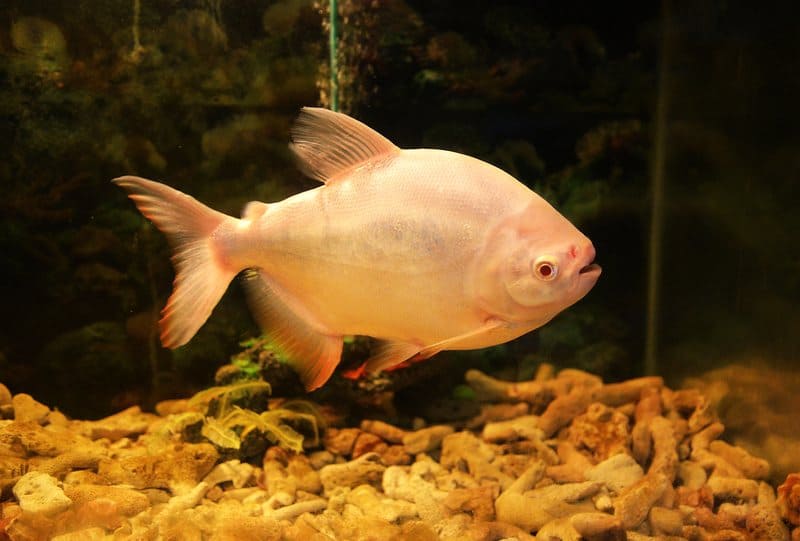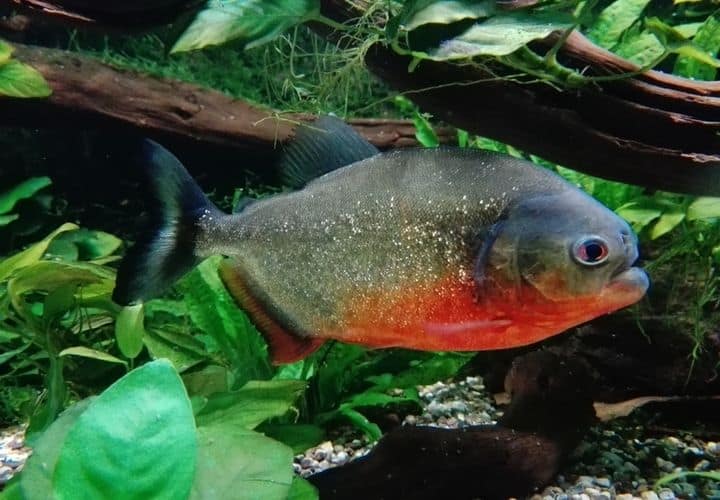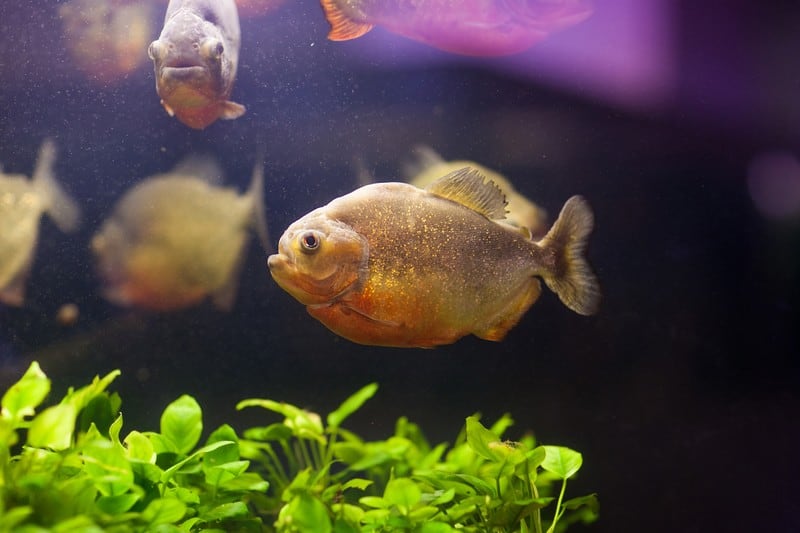Pacu or Piranha? This is a question that most if not all hobbyists have to deal with in their line of duty. If this sounds like you, then you are in the right place. In this article, we will highlight the main difference between these two distant cousins.
What is the difference between Pacu & Piranha? The main difference is that pacu fish are predominantly herbivores, while piranha varieties are omnivores. Piranha teeth are sharp and razor-like while pacu teeth are blunt and short. Equally, piranha are schooling fish while pacu prefers to live singly.
Well, if you want to decipher about these two fish, let’s cut to the chase and see how they differ. Ready? Let’s go!
Difference between Pacu and Piranha
| Fish | Pacu | Piranha |
| Size | Grow up to 30 inches and weigh about 50 pounds | Grow up to 17 inches and weigh about 7.5 pounds |
| Shape of teeth | Have short and blunt teeth | Have small, razor-sharp and triangular-shaped teeth |
| Diet | They are predominantly herbivores | They are predominantly omnivores |
| Behavior | Tend to live singly and are territorial | Thrive in groups |
| Breeding | They leave the eggs to hatch on their own | Tend to the eggs until fry can swim on their own. |
| Source of food | Vegetables, seeds, small fruits | Small animals and fish; snails; meaty commercial feeds |
Habitat in the wild
Both pacu and piranha fish originate from South America. Pacu fish are primarily found in the basins of Amazon and Orinoco River while piranhas are found in Essequibo river basin and some parts of Amazon River such as North-West Brazil.
Size
Both fish are considered large and require spacious aquariums. Pacu fish are however larger than piranha. The smaller species of the piranha variety can reach a maximum length of 4 inches while larger varieties grow to a maximum of 12 inches. In the wild, they can reach a maximum of 17 inches and weigh approximately 7.5 pounds.
On the other hand, their larger cousins – pacu – can reach a maximum size of 6 inches for small species while larger species reach a maximum length of 24 inches in an aquarium. In the wild, a fully grown pacu can reach 30 inches long and weigh about 50 pounds. The largest ever caught pacu was a whopping 36 inches.
Diet
As earlier mentioned, pacus are herbivores while piranhas are omnivores. As such, pacus enjoy veggies; however, they devour meaty meals once in a blue moon.
In the wild, they’ll predominantly feed on aquatic plants, seeds, roots, etc. therefore, reciprocate the same in your aquarium by providing spinach, peas, and raw potatoes, etc. equally, feed them with plant-based commercial foods.
Piranhas, on the other hand, are known for their feeding frenzies. They can devour a small fish in an eyelash, especially when they are in a group. While they might not devour on you, they prefer small animals, fish, some veggies, snails, and commercial feeds. Again, ensure you feed both once a day since more than this is considered overfeeding.
Behavior
Well, while piranhas thrive in groups, pacu tend to assimilate the “lone wolf” personality as they grow. As such, it would be prudent to keep them in separate tanks once they mature.
Similarly, pacus tend to become territorial and might become aggressive towards tank mates. However, you can always keep them together with large, peaceful but not timid fish since they occasionally nip fins.
Piranhas are schooling fish that prefer staying groups while still young. However, some species tend to isolate themselves, becoming extremely territorial.
They are compatible with smaller fish which are peaceful. Guppies and tetras make the best tank mates. However, provide piranha with quality feeds so that it doesn’t feed on tank mates.
After mating, pacus leave the eggs to hatch on their own. Once hatched the fry fend for themselves. On the contrary, piranha will tend to the eggs and fry. Fry tend to hide under plant cover until they are mature enough to swim on their own.
Breeding
It is impossible to breed the pacus and piranhas fish in a tank. As such, a fish pond is an ideal location.
Tank and water conditions
As you know, both pacu and piranha grow to enormous sizes, which translates to large tanks. Both will require the same conditions. Let’s look at them:
Tank size
A single piranha will thrive in a 30-gallon tank or more. If you desire to keep at least five piranhas, then a 100+ gallon tank will do the trick. Upon maturity, these fish thrive in larger tanks such as public aquariums.
Likewise, pacu fish will require even larger tanks since they are larger than piranha. Therefore, a 50-gallon tank for a single fish is recommended. Adults will require huge tanks – more than 1-ton capacity. Well, if you can afford such, go for it!
Water conditions
Since both are tropical fish, you will need a heater to keep the water temperature between 25 and 29 C. keeping them in cooler waters hampers their immune system making them susceptible to infections and diseases. Likewise, warmer waters become deprived of oxygen, which leads to a weak immune system. A pH of 6.0-8.0 is ideal for both.
Decorations
Both fish enjoy hiding places in the wild, which should be reciprocated in the aquarium. However, the piranhas are not particular when it comes to hiding spots since they tend to remain stationary for long.
As such, do not provide too many rocks and live plants in their tank. Additionally, they are known to destroy plants, but ferns and hornworts have proved to withstand their aggression.
Pacu will enjoy more hiding places compared to piranhas. Even so, provide amble swimming space where they can dart on prey without hindrance. Similarly, decorations should not be sharp as these might hurt your fish as it plays around with them.
Lighting
Both fish will thrive in soft light and still feel comfortable.
Tank Mates
Which are the best tankmates for pacu?
While pacu can thrive alone in a tank, there are a few compatible fish. In essence, these fish are large and overly peaceful. They include:
Oscar fish
- Temperature: 24-27 C
- Tank size: 100 gallons
- Adult size: 18 inches
- Temperament: territorial
- Diet: omnivore
Oscar fish are large fish that require large tanks for them to thrive, especially when introduced to a community tank. To start with, keep a group of 5-6 juveniles and let them choose their mates. Once paired, keep them in separate tanks. It can feed on almost anything you provide.
They are very active swimmers; therefore, you should provide cover for your heaters and provide smooth décor. Due to its burrowing behavior, sand is the ideal substrate. Equally, provide bulky decorations and well-anchored plants since it tends to pull and throw things around.
Green terror
- Temperature: 20-24 C
- Tank size: 100 gallons
- Adult size: 12 inches
- Temperament: territorial
- Diet: omnivores
These are brightly colored cichlids covered by green-blue scales. They are easy to care for since their diet is not demanding. Even so, you need to provide a qualitative diet for it to thrive with tank mates. They are aggressive and as such should be kept with similar large fish like pacu.
Green terror are sensitive to abrupt changes in water conditions, making them not ideal for novice hobbyists. They are omnivores feeding on anything from veggies, live and frozen food, commercial feeds, and meaty meals. They require a pH of 6.5-8.0 to thrive.
Which are the best tankmates for piranha?
Piranhas thrive in a community with large fish such as:
- Striped Raphael catfish
- Temperature: 24-26 C
- Tank size: 3o gallons
- Adult size: 8 inches
- Temperament: peaceful
- Diet: omnivores
They are some of the medium-large catfish in the market. They are active at night. Even so, they can adjust to the daylight. They have a rather tough skin that protects them from injury inflicted by aggressive fish. Interestingly, they make a croaking sound when being fed hence the name “talking fish.”
These bottom feeders feed on anything they find that the bottom of the tank. However, supplement their diet with vegetables, pellets, flakes, and live foods such as earthworms. They live for 15 years in the right conditions.
Common Pleco
- Temperature: 24-26 C
- Tank size: 60+gallon
- Adult size: 24 inches
- Temperament: peaceful
- Diet: omnivores
These are bottom dwellers that spend most of their time hiding in caves or under plant cover. They are active during the night and twilight hours. The water of pH level 6.5-8.0 is the most ideal for this fish. These tank cleaners mostly feed on algae and vegetables.
Even so, provide live and frozen foods for optimal nutrition. Not to mention that its behavior to jump out of water. As such, you should invest in a bulky and tight lid. Overall, they make a perfect tank mate for piranha and are easy to care for.
Black pacu
- Temperature: 24-27 C
- Tank size: 650 gallon
- Adult size: 40 inches
- Temperament: peaceful
- Diet: omnivores
Black pacu also make suitable tank mates for piranha fish. Although they like meaty meals, they’ll often fall for plant food. Even so, they’ll feed on small fish if they starved. Therefore, ensure you feed it on qualitative meals. They should include vegetables, live and frozen food such as blood worms, and commercial foods.
Unlike most pacu, black pacus are peaceful and tend to thrive with other tank mates. They can grow to a maximum size of 108 cm almost outgrowing most indoor aquariums. Thanks to their human-like teeth, they are known to crack nuts and even bite prey to the bone. The male is brightly colored compared to the female.
Other compatible fish are sailfin Pleco, black pacu and Bristlenose Pleco.
Related Questions
How do you identify piranha? They have triangular-shaped, razor-sharp teeth
How big do pacu fish get? 24-30 inches
Are pacu legal in California? No, it is illegal to farm, transport or import pacu in California. Why? Because they are not initially from this state.
Is it legal to own piranhas in the US? It depends in which state you are. Let’s look at the states where you can and cannot keep piranhas.
| States where piranha is illegal | States where piranha is legal |
| California, Nevada, Washington, Idaho, Utah, Texas, New Mexico, Arizona, Oklahoma, Florida, South California, North California, Kentucky, Virginia, New York, Louisiana, Mississippi, Arkansas, Alabama, Carolina, Hawaii, Massachusetts, Maine | Montana, Oregon, Wyoming, North Dakota, Minnesota, Iowa, Wisconsin, Michigan, Indiana, South Dakota, Nebraska, Kansas, Missouri, Tennessee, West Virginia, Pennsylvania, Ohio, New Jersey, Maryland, Vermont, New Hampshire, Delaware, |
Are pacu fish endangered? No, while they are a source of food in South America, they are regarded as invasive species in most states of the USA.
Are pacu fish edible? Yes, they are sold in numerous restaurants in South and North America. Chefs like cooking them since they have a fat belly that prepares quickly.
How long do pacu and piranha fish live? Pacu and piranha fish can live for more than 20 years when kept in optimal conditions.
Can piranha live in saltwater? No, they are freshwater fish.
Which are the most common piranha aquarium varieties? Black piranha (redeye piranha) & Red-bellied Piranha.
Which are the most common pacu aquarium varieties? Black pacu, black finned pacu and red-bellied pacu.
Why are piranhas harmful to the environment? It is because when introduced in a pond or stream, they breed in large numbers, colonize the new habitat and feed on other fish species destroying the ecological balance.
How long can pacu go without food? Pacu can survive for a week or so without food. However, given its obnoxious appetite, it can become aggressive once the food is introduced in the tank.
Bottom-line: Which one should you keep?
Keeping these two species can be a daunting task since they outgrow most indoor tanks. Nonetheless, if you can afford a 1-ton tank, then you can go ahead and keep them. Again, check which state you are from since pacu and piranha are restricted in most states.



